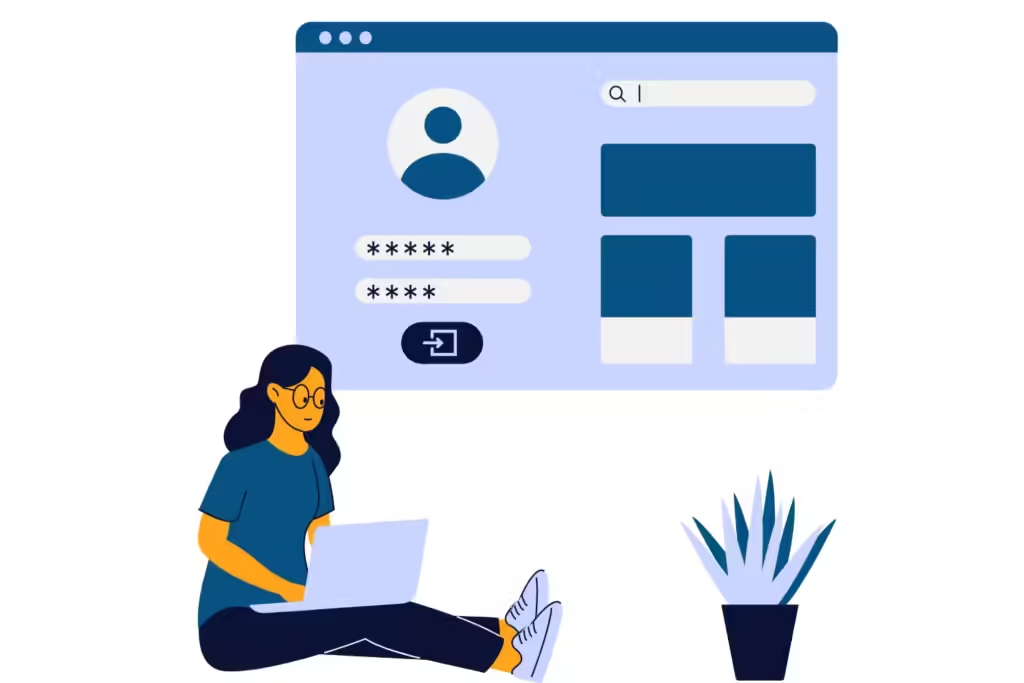A user-friendly website is vital for your bottom line. It determines the ease of usability your site has for lead generation, conversions, SEO, and more. In contrast, poor site usability can make it harder for people to navigate, leading to higher bounce rates, lost sales, and dropped keyword rankings.
Learn more about the significance of website user-friendliness and how to achieve successful usability to support your business goals.
What Does User-Friendly Mean for Websites?
The meaning of user-friendly for websites is making them easier for people to use. They should be able to browse, search for information, and complete actions on your site quickly and easily.
Not to be confused with user experience (UX), which focuses on your site’s overall experience for people, whereas usability is for specific tasks. However, user-friendliness falls under the UX umbrella. Anyone should be able to use your site’s features easily and have a positive perception throughout the process.
For example, if your website has an easy-to-use custom product builder, but your page takes too long to load, it can compromise its usability. User-friendly sites and UX design go hand-in-hand.
Designing for Users: 10 Key Attributes of User-Friendly Websites

Learn the top 10 attributes of user-friendly websites with mistakes to avoid, tips on implementing them, and why each one matters.
1. Responsive Moblie & Desktop Design
Your website’s security is arguably the most important reason to take care of it. If your site’s platform hasn’t been updated to the People browse, research, and shop on mobile devices more than ever. In August 2024, studies show that nearly 62% of website traffic is from mobile users. At the same time, this doesn’t mean to neglect your desktop users.
Compared to mobile, people using desktop devices visited 100% more pages and spent almost 38% more time on websites—an average of four to seven pages than mobile’s three!
That’s why having a responsive website design on desktop and mobile is crucial.
A responsive website means its layout can easily adapt to any screen size. If your site has the same design for all devices, it can make it harder for people to navigate, a.k.a. not user-friendly. Examples of non-responsive web design include shrunken pages on mobile that make your text too small to read or grainy images that stretch too far on desktop.
You can optimize your site with user-friendly responsive design by:
- Testing your website on different devices after major updates to ensure everything remains responsive
- Using flexible website grids and layouts via CSS (Cascading Style Sheets) code for optimal screen resolutions and orientations (portrait, landscape, iPads, Android phones, etc.)
- Implementing max-width image source codes so they resize proportionally to all devices
- Minimizing UI (user interactive) elements to prevent cluttering your site’s layout and complicating navigation
2. Fast Page Load Speed
Did you know if your website takes more than three seconds to load 40% of users will leave? In a rapid digital age, you can’t afford to lose visitors for slow page load speed.
Common reasons for slow websites include:
- Large media files like long background videos and non-optimized images
- Insufficient web host plans that share servers with other websites, slowing your site’s queue and lowering server performance
- Limited CDN (Content Delivery Network) capabilities with smaller networks and no caching features
- Dated CMS (content management system) that hasn’t been updated regularly or has many unused plug-ins
- Unoptimized CSS and Javascript code with unnecessary rules or dense code, leading to increased HTTP requests your server can’t handle
You can improve your website’s page load speed with the following:
- Compressing large media files and resizing them to a lower resolution
- Upgrading your web hosting plan or switching providers with larger networks
- Using CDNs with caching features for browsers and servers
- Downloading CMS updates regularly and removing unnecessary plug-ins
- Minifying CSS and Javascript code to reduce the number of files loaded on your web pages
Not to mention, slow page load also impacts your website’s technical SEO performance, like lower SERP rankings and reduced crawl rates. Google prioritizes fast-loading sites because it strengthens UX with quick content access.
Additionally, poor technical SEO makes it harder for search bots to crawl your website, delaying the indexing process. If Google takes a while to discover (crawl) and index (store) your site in their database, it’s essentially invisible online to users.
3. Seamless Navigation

Your website’s navigation can be the main reason users browse or bounce. A beautifully designed site is nothing without successful functionality. If your website has no breadcrumbs for users to return to a page easily or has cluttered menu bars with too many web pages, it makes it harder for people to navigate.
User-friendly websites provide a seamless navigation experience, including:
- Organized menu hierarchy by page priority with the top ones in the beginning, the lowest in the middle, and the contact page at the last
- Simplified menu bar design with a short list of options at the top header or side (seven maximum is recommended for most sites)
- Implemented breadcrumbs for users to backtrack easier or for sites with complex structures
- User-focused navigation experience with a recognizable search bar and accurate content label categories
4. Clear CTAs & Proper Placement
As a business, your website must encourage users to take action. Whether it’s generating user engagement, leads, or conversions, your site should have various calls to action (CTAs) for your bottom line. CTAs prompt user interactions by guiding them to take the next step, like submitting a contact form, scheduling a demo, or downloading a free guide.
However, your CTAs require a careful balance to prevent them from making your site less user-friendly. Using too many pop-ups can overwhelm people, adding buttons that aren’t recognizable can easily be missed, and writing non-persuasive copy can make them ineffective.
User-friendly websites have clear and impactful CTAs, including:
- Adding CTA buttons with bold colors, responsive sizing, and easy-to-find placement
- Minimizing pop-ups that are distracting or spammy and make users bounce
- Using persuasive CTA copy with action-oriented verbs that support the page’s content appropriately, like “Start Your Free Trial Today” instead of “Sign Up”
- A/B testing your CTA buttons to see which designs resonate with users more
5. Compliant User Accessibility
Your website must be accessible to all users by law. The Americans with Disabilities Act (ADA) now requires business websites to have accessibility-designed features and functionalities for disabled users.
The ADA’s website accessibility guidelines include:
- Writing descriptive image alt text for blind users to understand the purpose of your visuals, including pictures, logos, and charts
- Using screen readers that speak the text of your web pages and online forms for blind users
- Implementing keyboard navigation for users who cannot physically access a website via mouse
- Adding captions to your videos for people with hearing disabilities
You should also check with your state and local governments if they have specific regulations for website accessibility requirements. Remember, user-friendly sites are meant for all users.
6. Balanced Layout Design

Adding more website designs and features doesn’t always mean better when it comes to user-friendliness. In fact, it can do the opposite for your site’s usability. Text-heavy pages and too many visuals can make your site look cluttered and harder to read for users.
User-friendly site designs include:
- Contrasting page colors to create a balanced layout design
- Ample white space to break up heavy text
- Easy-to-read fonts with sufficient sizing on all devices
- Appropriate number of visuals that support your page’s content without distraction
7. Organized Content Structure
Site maintenance costs depend on several factors, including:
Your website’s content must pass the scanability test for users and search engines alike. They should be able to quickly scroll and know instantly what it’s about to ensure your site’s content has strong usability and SEO performance.
User-friendly content formatting for websites includes:
- Headings, subheadings, bullet point lists, and small paragraphs with four sentences minimum for easier readability
- Proper heading hierarchy for search engines to crawl and index faster (Ex: One H1 per page)
- Keyword-optimized heading titles that briefly and clearly describe the content sections below it for search engine relevancy and user understanding
Organized website architecture can boost your conversion rate six times and be your highest ROI driver over time.
8. Simple Online Forms
Your website’s online forms are how you capture contacts and generate leads. If you make this harder than it should be, users can easily leave in the middle of filling them out due to the inconvenience—potentially losing customers from poor usability.
User-friendly forms should be straightforward. Include the minimum number of form fields you require, like name, phone number, email, and a button to submit their information. Adding too many required or optional fields can reduce your form’s lead generation as a result.
You can also strengthen form usability by having an option to save their contact information for future use. Returning customers like the convenience of minimal clicks to check out their purchases.
9. Clean Code & Valid Markup

Having clean site code and valid markup is not only beneficial for users but also for your web developers to enhance its usability more easily. Cluttered or error-filled code and invalid markup, like missing tags, make it harder for developers to read for regular website maintenance, scale it for site redesigns, and troubleshoot it for technical issues when necessary.
On the user end, sites with organized code and proper markup language have stronger browser compatibility and SEO performance.
In addition to different devices, users visit websites with various browsers, like Chrome, Firefox, and Safari, which all interpret web pages differently. Since quality code is more stable with fewer loading errors, it allows your site to have a consistent browser experience so its usability performs and looks as it should across all of them.
Regarding SEO, clean code makes it easier for search bots to crawl and index your site’s content because they’ll understand it better. In return, it can improve your site’s visibility and keyword rankings for search engines because it’s optimized for them.
You can check if your website has user-friendly code and markup language with the following:
- Code comments for future web developers to reference without overdoing them
- SEO crawlers, like ScreamingFrog, flag and help you fix HTML errors on your site
- Code cleaner tools, like DirtyMarkup, reformat your disorganized HTML, CSS, and JavaScript code
10. Valuable User Feedback
Who better to learn how to make your site more user-friendly than the people you’re designing it for? Your users know what they like and don’t like from your website the best. You can gain valuable insights from the people you’re trying to attract directly.
Online surveys are a simple way to get feedback on the user-friendliness of your site. You can add them to the home page or in email blasts and even offer incentives for users to fill them out, like one-time discounts or gift cards.
Include questions in your site’s surveys like:
- On a scale of 1 to 10, how easy was it to find what you were looking for?
- How likely are you to recommend our website to people you know?
- What features would you like to see added or changes to be made to our website?
- Did you experience any technical issues while using our website?
Don’t Push People Away: Make Your Site User-Friendly Today
Don’t push potential customers away from your website with poor user-friendliness. Your site is a significant investment and the foundation for your business. It should attract your target audience and keep them by making it as easy as possible for them to use.
However, it’s understandable to not know where to begin and have the time commitment to maintain since it’s multi-faceted. User-friendly websites require regular updates on the front and back end, which can be challenging for businesses to do themselves—especially if it hasn’t been maintained for a while.
At Reach Marketing Pro, we’re a full-service digital marketing agency with extensive experience designing, developing, and managing user-friendly sites. From website redesigns to UX optimization and custom code, we can improve your site’s usability in all aspects.
Ready to keep your users happy for your bottom line?
Learn more about our website design & development services, or contact us to make your site more user-friendly today!






